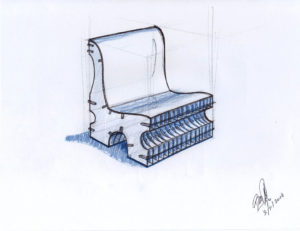Developing an Outcome for Safe Design and Build in an Online Context

“Chair Sketch” by makelessnoise is licensed under CC BY 2.0
This week I have been pulling together resources to meet an outcome that will help guide future teachers when teaching online. The outcome I have been mostly focusing on is related to my discipline as a technology education teacher: By the start of the year, technology education teachers will be able to create opportunities for students to safely design and build projects in an at home context. I chose this outcome because I know that it was a big struggle for me and other technology education teachers when the Covid-19 pandemic forced all teaching to go online. As technology education teachers, we have a duty to make sure that our students are as safe as possible and understand what safety precautions need to be met. With students at home and potentially unsupervised, we could not meet the standard of safety we are normally used to and so we had to adjust the way we teach and what we teach.
Evaluating Resources
To support the outcome, I compiled a group of resources, apps, and freely available online software to aid technology teachers in the future. These resources were measured against the Berkley Library framework for evaluating online resources to ensure they met a quality standard:
- Authority – Who is the author? What is their point of view?
- It was important that all resources were created by professionals connected to the education system and they and their work were held in high regard.
- Purpose – Why was the source created? Who is the intended audience?
- Some sources were created for profit and were included to show examples of what is available to teachers. Most sources were selected because they are free to educators and students.
- All resources were selected because of their connection to online education, especially to technology education.
- Publication & format – Where was it published? In what medium?
- Most sources came straight from company websites
- Several resources were created directly by professionals and shared on closed Facebook page only open to technology education professionals.
- Relevance – How is it relevant to your research? What is its scope?
- All resources were selected if they were relevant to online education and technology education.
- Date of publication – When was it written? Has it been updated?
- All sources were chosen as the most recent example available, most being from the last 5 years.
- Documentation – Did they cite their sources? Who did they cite?
- In this case, there was little citation from these sources and did not necessarily apply in addressing the overall outcome.
Design & Build Projects and Resources
I first pulled together a group of projects that students could do at home safely that meet the curricular standards of technology education courses. They mostly focus on designing and building using materials commonly found in the average home or could be easily sourced cheaply by students and parents. These resources were created by technology education teachers and most were used during the Covid-19 pandemic switch to teaching online. They were created to meet that new online reality and made available on a closed technology education teacher Facebook group to help others in their practice.
A couple of websites that offer resources, videos, and challenges are also provided. Most of these resources were made in response to the Covid-19 pandemic. Some are sponsored by various corporations (such as Lowe’s) but don’t appear to endorse said companies in any manipulative or problematic ways. These resources come in multiple media formats, such a documents and videos. Technology teachers may not find the challenges directly relevant to their subject matter, but they do offer an outline that can be followed to adapt the resources to meet classroom needs.
Online Design Software and Apps
I have also provided some links to online design software and apps that can be utilized by teachers and students to aid in the design process and open opportunities to create from home. These resources are all free to students and educators or have free versions that can be used by students. They can be used to model, make plans, and even create 3D printing and CNC programs.
What’s missing?
It should be noted that not every district is the same when it comes to deciding what can be done at home safely and what can’t. Technology education teachers should check in with their districts and get written outline of what is acceptable and what is not. I was able to have students do proper woodworking if an experienced adult was there to supervise. This was great for the students that had the supervision and tools but also raised some equity issues for the students who did not have those things. Unfortunately, most technology education courses cannot move to a full online format without losing a lot of what makes those classes fun for students and leads to more of a focus on theory over hands-on activities. It is my hope that these resources will help other technology education teachers maintain a hands-on course for their students, albeit in a slightly different approach.